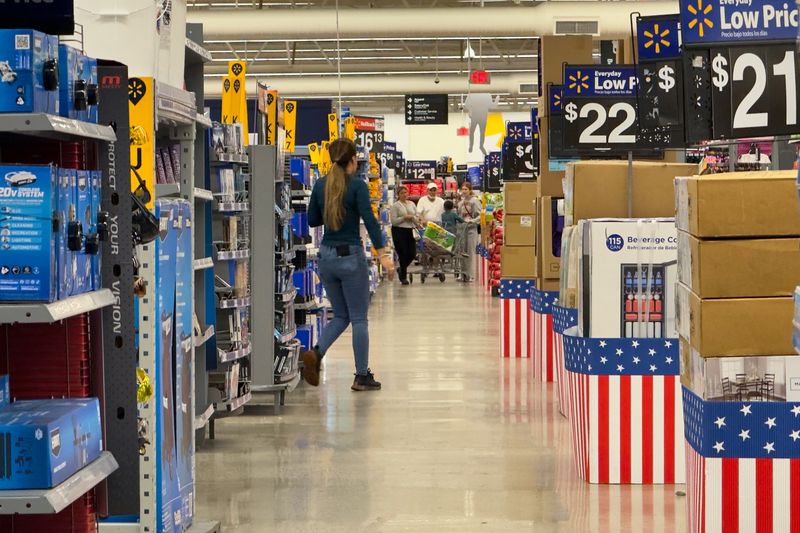
By Savyata Mishra and Siddharth Cavale
(Reuters) -Walmart on Thursday raised its fiscal year sales and profit forecast, driven by strong demand from shoppers across all income levels, who have turned to the world's largest retailer as they worry about rising costs.
Its shares, however, plunged 5% in early trading as its second-quarter profit was lower than expected, registering Walmart's first earnings miss in more than three years. Walmart's 12-month forward price-to-earnings ratio of 36.64 is nearly three times higher than Target's, indicating Walmart investors' high growth expectations.
Walmart's results show it has continued to benefit from growing price sensitivity among Americans, earning revenue of $177.4 billion in the second quarter. Analysts on average were expecting $176.16 billion, according to data compiled by LSEG.
The Bentonville, Arkansas-based chain got a boost from a sharper online strategy as more customers relied on home deliveries. Its global e-commerce sales jumped 25% during the second quarter, and Walmart said one-third of deliveries from stores took three hours or less.
Consumer sentiment has weakened due to fears of higher inflation due to tariffs, hitting the bottom lines of some retail chains, but Walmart's sales have remained resilient.
Walmart had warned it would increase prices this summer to offset tariff-related costs on certain goods imported to the U.S., a move that drew criticism from President Donald Trump. Several other apparel, footwear, and packaged goods retailers have issued similar warnings.
Consumer-level inflation has not surged as a result of tariffs, but it is increasing modestly, and wholesale inflation spiked in July to its fastest rate in more than three years.
Walmart CEO Doug McMillon said the impact of tariffs has been gradual enough to moderate any change in customer habits.
"But as we replenish inventory at post-tariff price levels, we've continued to see our cost increase each week," he said on a call with analysts, noting those costs will continue rising in the second half of the year.
SHOPPERS ADJUST TO HIGHER PRICES
McMillon also said he expects current shopping habits to persist through the third and fourth quarters. He noted that middle- and lower-income households are making noticeable adjustments in response to rising prices, either by reducing the number of items in their baskets or by opting for more private-label brands. This shift has not been seen among higher-income households, which Walmart defines as those earning over $100,000 annually.
Still, Walmart raised its full-year profit and sales forecast. Walmart expects annual sales to grow in the range of 3.75% to 4.75%, compared to its prior forecast of a 3% to 4% increase. Adjusted earnings per share are expected in the range of $2.52 to $2.62, compared to its previous range of $2.50 to $2.60.
Walmart Chief Financial Officer John David Rainey said the company is looking at more possible financial outcomes than before because of trade policy talks, uncertain demand, and the need to stay flexible for future growth. Based on what it saw in the second quarter, Walmart expects the impact on margins and earnings from the higher cost of goods and how it flows through the inventory to be smaller in the current quarter than it previously thought, Rainey said.
"Broad consumer and macro trends remain favorable to Walmart, especially in the shape of consumers wanting to maximize bang for their buck," said Neil Saunders, managing director of retail consultancy GlobalData.
"The result is a strong value equation that is pulling in a wider spread of customers, including those from higher income segments."
SECOND-QUARTER PROFIT BELOW EXPECTATIONS
The company's adjusted earnings per share of 68 cents in the second quarter fell short of analyst expectations of 74 cents.
"We think Street estimates got ambitious and the miss is not indicative of a slowdown in business fundamentals," said RBC Capital Markets analyst Steven Shemesh.
Walmart's total U.S. comparable sales rose 4.6%, fueled by solid demand for fresh food, pantry and dairy products, and branded and over-the-counter medicines, beating analysts' estimates of a 3.8% increase. The company noted strong customer response to over 7,400 "rollbacks," its term for discounted prices, with 30% more rollbacks on grocery items.
Average spending at the till rose 3.1% from an increase of 0.6% last year, but growth in customer visits fell to 1.5% from 3.6% in the year-earlier period. Walmart logged 40% growth in marketplace sales, including electronics, automotive, toys, and media and gaming.
A day earlier, rival Target warned of tariff-induced cost pressures, even as it reiterated that price increases would be considered only as a last resort.
Two-thirds of what Walmart sells in the U.S. is domestically-sourced, executives had said last quarter, which gave it some insulation from tariffs compared to competitors.
Walmart forecast third-quarter net sales growth in a range of 3.75% to 4.75%, excluding currency fluctuations.
(Reporting by Savyata Mishra in Bengaluru and Siddharth Cavale in New York Editing by Rod Nickel)

 Reuters US Business
Reuters US Business
 Associated Press US and World News Video
Associated Press US and World News Video The Texas Tribune
The Texas Tribune The Spectator
The Spectator The Spokesman-Review
The Spokesman-Review CBS Colorado Business
CBS Colorado Business KCRA News
KCRA News News 5 Cleveland
News 5 Cleveland The radio station 99.5 The Apple
The radio station 99.5 The Apple AlterNet
AlterNet